Why Your PIM Needs a Best
Friend: Accelerating Digital
Retail with Onedot
Messy and Unstructured data results in lost time and revenue
Product data is the foundation of modern commerce. But today’s systems, especially in medium and enterprise retail, are overwhelmed. Teams deal with thousands of SKUs from hundreds of suppliers, each with different formats, structures, missing attributes, or inconsistent naming conventions. It’s messy and unstructured, and that isn’t good enough. This messy and unstructured data results in lost time, increased manual effort, and most critically, lost
revenue. Products go live slowly or with incomplete or incorrect information. Customers bounce because they can’t find what they’re looking for. Return rates increase. And businesses lose more than sales, they limit their strategic options, from longtail assortment expansion to entering new markets.
All of this stems from one root problem: the industry lacks a scalable, intelligent solution for product data onboarding.
Integrating Product Data is the Biggest Problem in Commerce.
- Due to lack of standards, organisation/sales channel have own data structures how to describe products
- Each organisation needs to onboard 1000+ suppliers or match product data to 100+ sales channel
- Only products in high data quality and fast time-to-market achieve high conversion/revenue
- Today, data is prepared manually or using traditional software that can’t support the increasing data volume
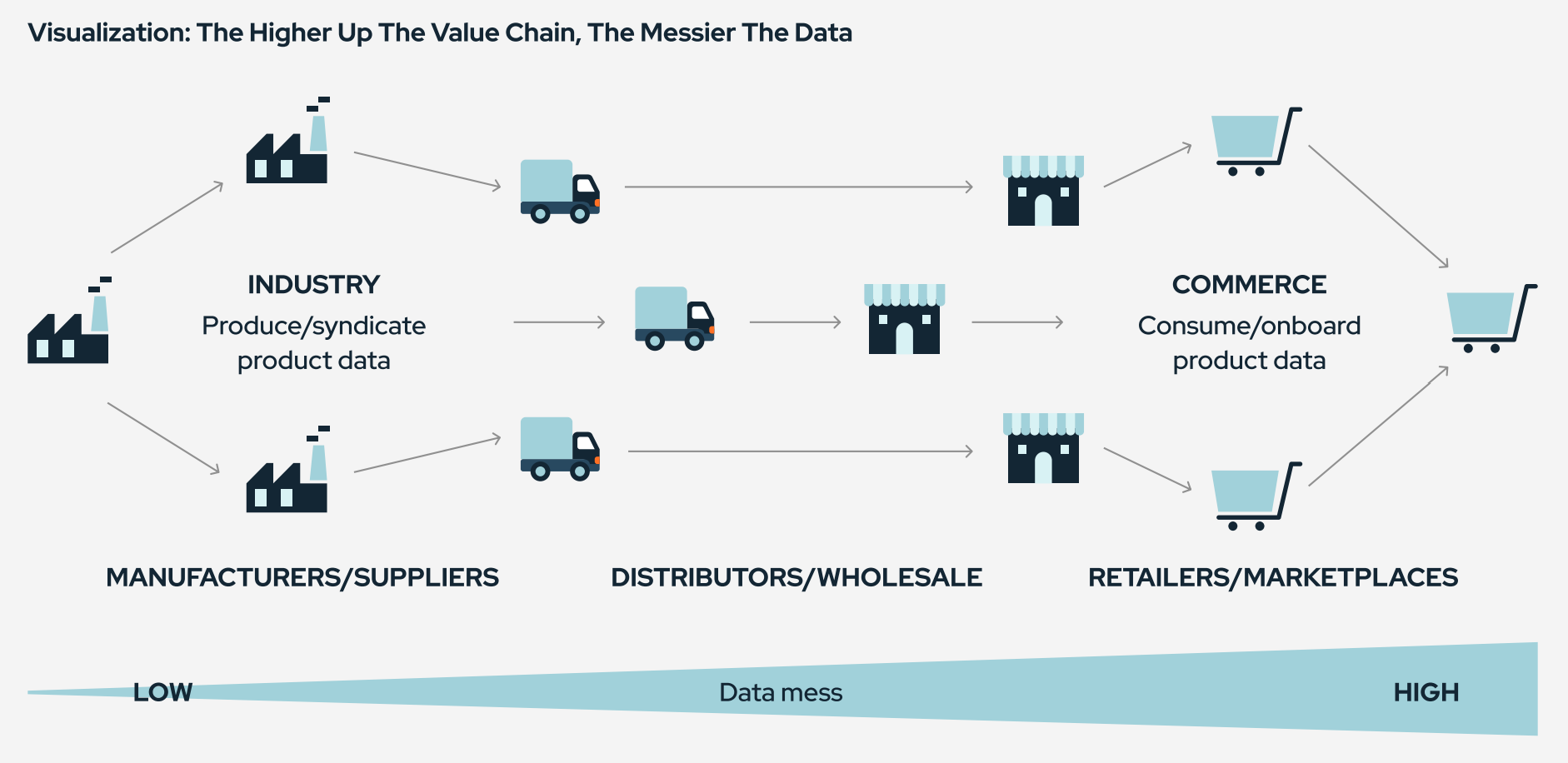
PIM Is Not Enough. And that's OK.
PIM is best understood as a concept made of three pillars: process, content, and system. It excels at managing structured data; centralizing, organizing, and distributing it across platforms. But it doesn’t source the data, nor does it fix what's broken at the beginning of the pipeline.
Let’s make one thing clear: PIM (Product Information Management) systems are essential. But they are not designed to do everything. And when businesses try to make PIMs responsible for onboarding messy supplier data, friction follows.
Expecting a PIM to handle data onboarding is like expecting your bookshelf to shelf the books themselves. PIMs are the place where content is stored and maintained but they need clean, normalized, and enriched product data to do their job effectively.
This is why retailers who rely solely on their PIM for onboarding end up buried in manual uploads, inconsistent data, and mounting frustration.
The Missing Link: Onedot
Onedot fills the gap between raw supplier inputs and your PIM. It is the best friend your PIM can rely on (not onboarding further problems).
Whereas PIMs focus on managing and distributing already-clean data, Onedot operates further downstream. It automates the collection, transformation, and harmonization of product data from various suppliers — no matter the format or source.
Here’s what Onedot delivers:
- Automation of supplier data ingestion
- Q Attribute extraction and matching
- Q Enrichment with rich content (images, descriptions, tech specs
- Q Real-time classification and normalisation
- Syndication-ready output for PIMs, ERPs, and digital channels
With Onedot, your PIM finally receives the structured, validated data it needs to perform, and your customers experience better product information across every touchpoint.
Where PIMs Hit Their Limits
Despite their importance, PIMs are not onboarding tools. And as the number of suppliers and channels increases, the cracks begin to show.
Retailers report consistent issues:
- Manual templates or Excel uploads that are time-consuming and error-prone
- Complex supplier coordination that lives in fragmented email threads
- Mismatched taxonomies and missing category assignments
In one example from a national trade day, a manufacturer and a retailer use completely different naming conventions and product categories for the same item. The result? Weeks of cleanup, and products that can’t be sold until someone manually reconciles the differences.
This isn’t a failure of PIM. It’s a signal that PIM needs a partner, a system that handles upstream messes and delivers structured data, ready for action.
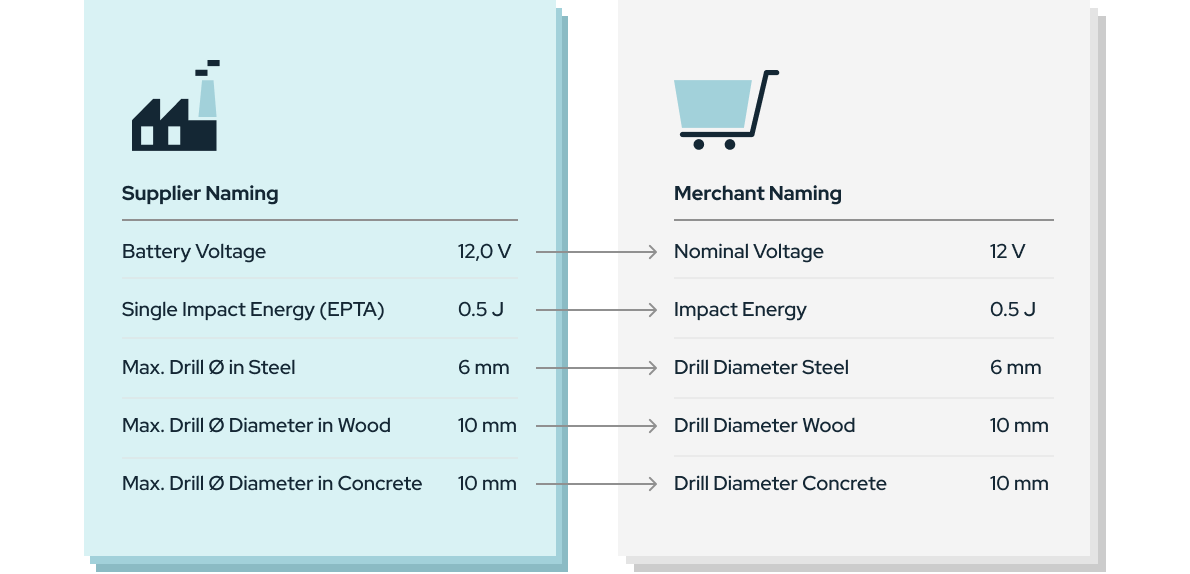
What’s Really Going Wrong With Product Data
Let’s walk through the common complaints we hear from retailers:
- “Suppliers send incomplete or poor-quality data.”
- “Some don’t send data at all.”
- “Our teams spend days chasing down missing files.”
- “Suppliers are frustrated with our forms.”
All of this adds up to one massive bottleneck, which is the inability to onboard product data efficiently.
That’s why Onedot is building Content Mining: a set of tools to extract and enrich product data directly from websites and PDFs, without relying on supplier action.
This automation layer removes the root cause of onboarding inefficiency — and lets retailers move at the speed of commerce.
Content Mining: Automated Input, Clean Output
Onedot’s Content Mining module, is designed for real-world retail challenges.
Instead of waiting for suppliers to send data manually, Content Mining pulls product data directly from public sources or that are easy for every supplier to deliver:
- Websites
- PDF catalogs and product datasheets
- Product data sheets or price lists
It then enriches the results:
- Adds descriptions, specs, various images, video links and downloads such as technical data sheets, product manuals, certification docs
- Product categories, applications and other taxonomies
- Similar products and matching accessories or spare parts
- Voice of Customers (VoC), User Ratings and User Generated Content (UGC)
General Benefits for Onedot Customers
Richer Product Information for an Optimized Customer Experience
- Product descriptions, content blocks with formatting, technical data, etc.
- Product categorizations, industries, applications, spare parts, etc.
- Complete and comprehensive product range is visible.
- Breakdown into individual SKUs (variants) in various languages.
- Voice of Customer (VOC/UGC): Ratings and other buyer feedback.
Attractive Digital Assets such as Images, Datasheets, Manuals, etc.
- More and higher-quality images, generally in good resolution.
- Links to videos with additional information.
- Downloads with more detailed product information, assortment details, brochures, etc.
Reduced Dependency on Suppliers & Efficiency Gains
- No more issues with suppliers who are unwilling, unable, incomplete, or always late.
- Increased autonomy and even faster time-to-market for product data.
- Efficiency improvements – especially through future direct integration into Onedot.
Improved Supplier Satisfaction
- Less pressure and effort (no more filling out Excel spreadsheets).
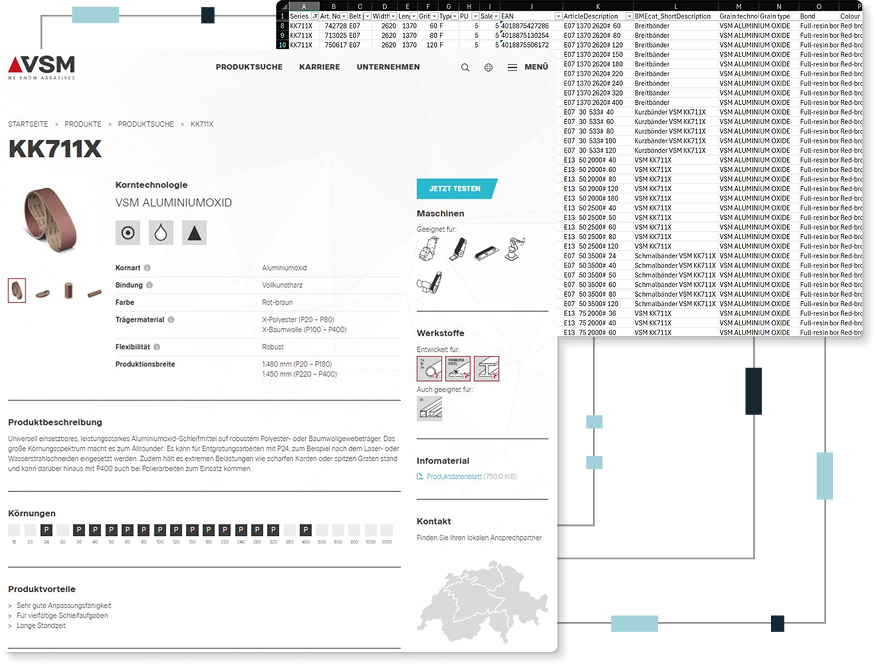
AI Is More than Just an Engine
Onedot’s AI isn’t a buzzword, it’s battle-tested and built to perform. Developed and refined for over a decade, it combines more than 70 person-years of machine learning expertise with training on a vast repository of community-contributed products. At its core is a best-in-class architecture of pre-trained and custom-trained models, blending Large Language Models (LLMs) with proprietary Small Language Models (SLMs). This is further enhanced by Retrieval-Augmented Generation (RAG) that retrieves relevant information from customized knowledge bases and vector stores.The powerful setup not only understands global classification standards like ETIM, ECLASS, and TecDoc, but it also adapts to your unique product data model, enabling smarter, scalable automation tailored to your needs.
- Customer-specific models: RAG and fine-tuning based on your existing product data
- Human Feedback loop: Improve accuracy with each review cycle
- Upcoming AI Quality Assurance agent: Additional AI agents to validate the data processed by the Ondot core AI
Benefit from 10 years of AI experience.
Onedot Models
- Pre-trained, hierarchical models are combined with customer specific models
- Customer-specific models are trained from PDE (Product Data Export) and user feedback
Onedot Algorithms
- Are available for all customers
- Are continuously enhanced by Onedot and through customer learnings
AI Agent (Outlook)
- AI agent that does quality assurance and online search

It handles everything from basic attribute mapping to advanced natural language transformations — and gets smarter with every use. When manual intervention is needed, it’s a one-time effort: once trained, the process runs automatically from then on.
Smart Supplier Collaboration Starts with Prioritisation
Not all suppliers need the same level of validation, or the same onboarding approach.
Efficient onboarding isn’t about doing everything for everyone. It’s about focusing your energy where it matters most. That’s why Onedot combines flexible collaboration tools with strategic supplier segmentation and validation options.
Prioritise by Impact
Different products and suppliers have different levels of business impact. With Onedot, you can tailor your onboarding strategy based on:
- Supplier importance (e.g. revenue contribution, exclusivity, profit margin)
- Product type (e.g. top sellers vs. longtail)
- Digital maturity (Excel uploads vs. API feeds)
Example:
- High-value suppliers? Prioritised onboarding with merchant validation.
- Longtail suppliers? Automated via AI or handled by external partners.
Choose the Right Validation Model
Onedot supports multiple paths to validated data:
Validator
Best For
Key Advantage
Merchant
Core and strategic products
Full quality control
Supplier
Decentralised onboarding at scale
Local data ownership
Service Partner
Outsourced or overflow work
No internal burden
Onedot AI
Longtail automation and pre-checks
Fast and efficient
You decide who validates what, and Onedot tracks it all. Note that lesser validated product records can be flagged as such - "Validated by AI" as "Automatically translated".
Collaboration, Built In
From file uploads to shared folders to threaded chats, Onedot creates a collaborative space where merchants and suppliers can:
- Send and receive data requests
- Chat on specific datasets or single product records
- Comment, validate, and approve together
- Track onboarding progress in one place
This is smart collaboration for scalable commerce.
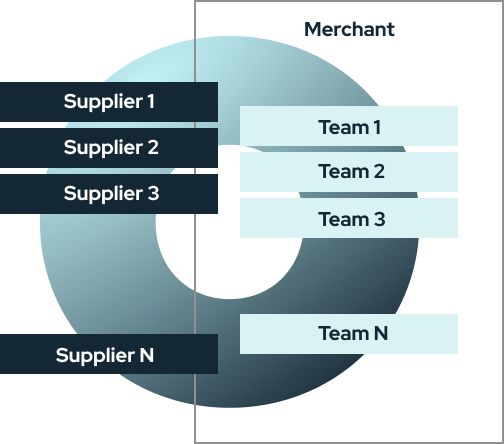
Collaboration on
Supplier
Merchant
Data requests
Receive
Send
Catalogue Data
Upload/analyse
Upload/analyse
Data folders
Own folders
See all data folders
Onboardings
Start, validate
Start, validate, approve
Data sets
Comment/chat
Comment/chat
Quality reports
Receive
Send
Questions
Ask
Receive, answer
From Unstructured and Messy Data to Commercial Impact
When product data is accurate, complete, and flowing fast, everything downstream performs better.
Let’s break down real-world results seen by Onedot customers:
- 5 times faster product launches: reduce time-to-market from weeks to days
- 5–10% increase in conversion rates: richer data = better findability and decision-making
- Up to 70% reduction in manual tasks: free up team capacity
- Fewer product returns: thanks to better specs and matching expectations
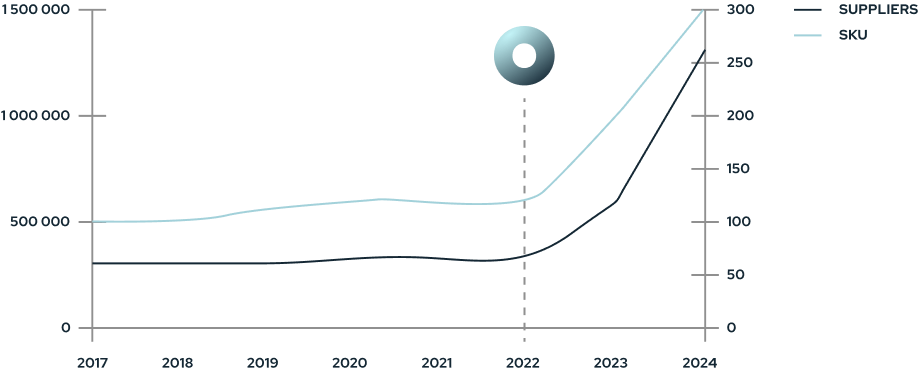
In one case, over 1 million SKUs were processed with:
- 4,000+ categories
- 8,000 attributes
- 120,000+ final products assembled
Onedot doesn’t just make your data better, it makes your business stronger.
Built for Retail (and Manufacturers). Trusted by Both.
Data collection and usage is evolving, fast. Retailers, and even manufacturers, need tools that are flexible, powerful, and purpose-built.
Why Onedot fits the high demand of modern businesses:
- Handles structured and unstructured data
- Works with all major formats (Excel, XML, BMEcat, JSON)
- Integrates via API, SFTP, or portal
- Offers modular onboarding, classification, enrichment, and syndication
It’s not another disconnected tool. It’s your full-service data onboarding engine — from supplier to shelf.

- 150+ suppliers onboarded
- 120,000 products / 1M+ articles processed
- Time-to-market cut to under 4 weeks
- Ongoing updates in <1 week
“E/D/E differentiates itself on the market through a comprehensive data strategy with the highest quality standards. In Onedot, we have found a technology partner with whom we have been able to digitalize our data maintenance processes and use artificial intelligence in a targeted manner.”
Key Benefits for E/D/E
E/D/E, similar buying groups and every retailer benefits from:
Richer product information
- Full descriptions, specs, categories, and more
- Visibility into the entire product assortment
Better digital assets
- High-resolution images
- Instruction manuals, data sheets
- Video links, brochures
Less reliance on suppliers
- No more delays from missing or incomplete data
- Increased speed and autonomy
Happier suppliers
- No more Excel uploads or PDF juggling
- Less friction, better cooperation
This is how you create a scalable, intelligent, and enjoyable product onboarding process.
When to Bring In Onedot
Whether you have a PIM or not, Onedot is built to plug in easily and effectively.
- Already have a PIM? Enhance it. Let Onedot clean and prep your data.
- Planning a PIM rollout? Bring Onedot in from the start to speed up time-to-value.
- Migrating from one PIM to another? Use Onedot as a bridge — no manual rework.
- No PIM yet? Start your data stack with a strong onboarding foundation.
No matter where you are, Onedot brings speed, clarity, and consistency.
Summary
Let’s recap:
- PIMs are great, but they can’t fix bad data
- Onedot is the onboarding engine your stack needs
- AI-powered, human-validated, and built for scale
Let’s make product data onboarding a growth driver, not a growth blocker.
